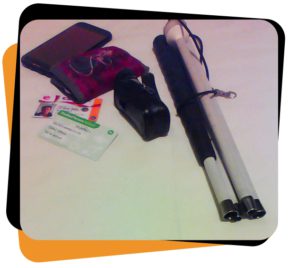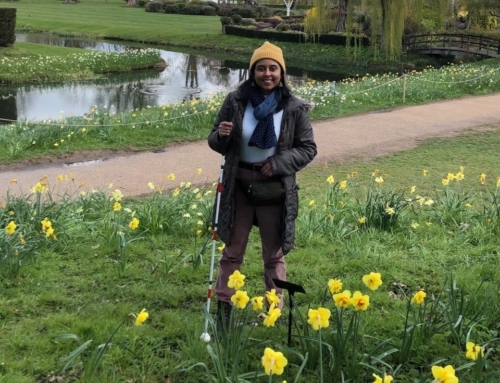by Michael Alford
 Have you ever wondered what it might be like going out on your own or perhaps with friends, possibly all VI, but never quite had the confidence to do it? Do you have an adventurous side that wants to get out and explore? Going out as a VI person can be a daunting prospect, but living in the UK means that there’s plenty of equipment and support available to assist the VI in travelling independently (note that not all countries are as good as us by the way, so see some of the other articles for tips for international travel).
Have you ever wondered what it might be like going out on your own or perhaps with friends, possibly all VI, but never quite had the confidence to do it? Do you have an adventurous side that wants to get out and explore? Going out as a VI person can be a daunting prospect, but living in the UK means that there’s plenty of equipment and support available to assist the VI in travelling independently (note that not all countries are as good as us by the way, so see some of the other articles for tips for international travel).
But having all the right equipment and knowing how to access the support required isn’t necessarily enough. It’s still challenging knowing whether you are ready to face independent travel.
Ultimately, it all comes down to your attitude – given the right equipment and support, are you willing to get up and try a little exploring? It is not an untrue cliché that many of the perceived barriers are more imaginary than real.
Do Your Prep
 I have often found it to be all too true that the most enjoyable trips are those where a little planning has been done, and that’s mainly on the basic level of planning your itinerary, not to mention the importance of planning to ensure you’re not going to run into some inaccessible spots that you could have avoided. Even just a quick check on Google Maps to plan your routes can go a long way to ensuring that you can easily get to where you want to go. If your sight and mobility skills are up to it, try digging a little deeper. Are there perhaps heritage-based attractions in the area that might provide transportation to your intended destination, e.g. ferries or heritage railways? Although such attractions are not always as accessible as the national public transport network (National Rail, commercial bus and coach services, and similar), they often provide convenient connections between areas well served by dedicated public transport to those that are not so well served, but still well worth a visit.
I have often found it to be all too true that the most enjoyable trips are those where a little planning has been done, and that’s mainly on the basic level of planning your itinerary, not to mention the importance of planning to ensure you’re not going to run into some inaccessible spots that you could have avoided. Even just a quick check on Google Maps to plan your routes can go a long way to ensuring that you can easily get to where you want to go. If your sight and mobility skills are up to it, try digging a little deeper. Are there perhaps heritage-based attractions in the area that might provide transportation to your intended destination, e.g. ferries or heritage railways? Although such attractions are not always as accessible as the national public transport network (National Rail, commercial bus and coach services, and similar), they often provide convenient connections between areas well served by dedicated public transport to those that are not so well served, but still well worth a visit.
There is a huge range of aids that can be hugely beneficial on a trip out. Here are a few things I find useful as a VI person and never leave home without – this list is certainly not exhaustive when it comes to all the equipment available, but hopefully it will give you an idea of how a few simple items can go a long way in helping me get to where I want or need to go independently.
- Railcard – train fares are pretty expensive, so if you travel by train regularly, why say no to a third off, not only for you, but also for a carer/companion? Anyone with a disability is entitled to it, but there is an initial cost, which at the moment is £20 for a year or £54 for 3 years.
- Bus pass – free bus travel on weekdays after 09:30 and all day on weekends is another perk of being VI. It’s not quite meant to fund your daily commute, but it does help for leisure travel. The scheme is run by local government, so the application process will depend on your local authority.
- Monocular – a pocket size telescope useful for seeing any detail too far away for me to see unaided, from signs and info boards to stunning views and intricate craft work on a building. Try asking your low-vision optician or local sight-loss charity.
- Mobile phone – from apps that show my bus ticket, to apps that help with navigation (I just use Google Maps), and even just the basic function of phoning for help when things go wrong, mobile phones have proved themselves almost indispensable to the visually impaired, as much for mobility as in household activities or anything else.
- White cane – it’s another obvious one, but a cane really is a useful tool. Carried folded up while walking on fairly level routes, a long cane or guide cane is as good as a symbol cane as a subtle cue to those around that a partially sighted person is on the move, while its uses when unfolded to make contact with the ground are numerous, placing it securely on the list of must-haves for those with more severe sight impairments. Ask your mobility specialist if you are not sure what the different canes are and what each can do for you.
Try asking your mobility trainer about what other equipment they know of that might help you, or have a look online. It’s also worth talking to your mobility trainer about the support for the disabled on public transport and at most places of interest. It can be easy to take it for granted just how much support there is available. From level access in the vast majority of buildings, to public transport vehicles with high contrast doors, and written information being widely available in an increasing variety of accessible formats, the amount of effort made to make almost every aspect of life (including travel) accessible can be quite staggering. It’s also becoming a lot easier to get help while out and about on your own – many people are willing to offer help if you need it, and most transport operators and tourist attractions have well planned procedures for assisting the disabled, e.g. rail assistance on the national rail network. While it is true that the proper assistance isn’t always as forthcoming as we might expect, there are also many instances when it works extremely well. Having grown up in South Africa, where there is virtually no public transport, and certainly no thought given to accessibility anywhere, I have to admit to appreciating just being able to make the daily commute independently by bus.
Break that Mental Barrier
So, we go back to the same old point; it’s up to you and your willingness to take on the challenge, break down the barrier, and try something new. You’ve done your prep, you know where you’re going and how you are getting there, you’ve booked whatever assistance you need, so how much can go wrong? Probably not much more than might go wrong for a sighted person doing the same thing as you, and that’s nothing that can’t be fixed.
Consider how you might solve some of the problems you are worried about coming across. Most problems can be solved if you keep your cool and ask for help – most people are willing to give it. Police officers, staff in a train or bus station, even customer service assistants in shops can all provide directions. Ask yourself, “what is the worst that can happen?” On a local bus trip, getting on the wrong bus or missing your stop might be a pain (and I know because I’ve done it), but it will only cost you the extra time spent if you’ve used your bus pass. If you’re travelling by train with rail assistance and there’s a communication breakdown or other mistake somewhere, no great need to panic – the railway staff are there to help and they can hardly charge you for their mistakes. The worst is often not as bad as you think.
Explore!
You’re now prepared for almost any eventuality or challenge, so what are you waiting for? The whole country is your oyster! Need some more inspiration? Here goes.
What do you like doing? What are your interests? Shopping? Going out with friends for a bit of food and drink? Having a workout at the gym? Most towns and cities have a good public transport network, so it’s quite easy to get around without the ability to drive a car, and a few local trips where mistakes won’t be such a big problem, might help build your confidence to travel further afield. My first independent journeys were routine school commutes by bus; travels further afield came later when I was more used to the procedure.
But let’s be honest, I’m a bit more adventurous than just doing routine local trips; I like to get out into the country. Spectacular scenery, unspoiled cultural heritage, peace and quiet, fresh air; what’s not to like? I’m sure I’m not the only person like that who’s visually impaired, so if that’s you as well, then I’ve written this article mainly with you in mind. It’s easy (and not entirely untrue) to think that many rural areas aren’t well served by public transport, but there are also many that are, especially the more populated areas. True, it is a bit more time-consuming, with slow, infrequent services and many stops, but surely it is better than sitting at home wishing you could go out and see somewhere new?
Go on then; it’s now up to you. Try researching how to get to that amazing place that you’ve always wanted to go to but never thought it possible with your visual impairment, then plan your trip and go! You might be quite surprised at how easy it all is.
Written by Michael Alford












Leave A Comment